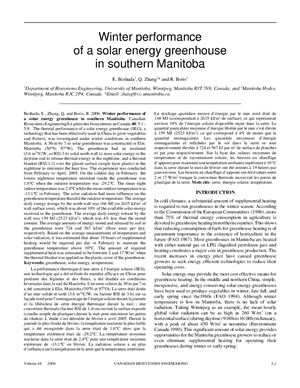На английском языке. Статья опубликована в ж. Canadian Biosystems
Engineering, 2006, V. 48, P. 5.1 -5.8.
Abstract.
The thermal performance of a solar energy greenhouse (SEG), a technology that has been effectively used in China to grow vegetables and flowers, was investigated under winter conditions in southe Manitoba. A 30-m by 7-m solar greenhouse was constructed in Elie, Manitoba (50°N; 97°W). The greenhouse had an insulated (3.6 m2°C/W, or RSI-3.6) solid north wall to store solar energy in the daytime and to release thermal energy in the nighttime, and a thermal blanket (RSI-1.2) over the glazed surface (single layer plastic) in the nighttime to minimize the heat loss. The experiment was conducted from February to April, 2005. On the coldest day in February, the lowest nighttime temperature recorded inside the greenhouse was 1.6°C when the outdoor temperature was -29.2°C. The mean night indoor temperature was 2.4°C while the mean outdoor temperature was -13.1°C in February. The solar radiation had more influence on the greenhouse temperature than did the outdoor temperature. The average daily energy storage by the north wall was 166 MJ (or 2635 kJ/m2 of wall surface area), which was about 10% of the available solar energy received in the greenhouse. The average daily energy release by the wall was 159 MJ (2523 kJ/m2), which was 4% less than the stored amount. The average amounts of energy stored and released by soil in the greenhouse were 724 and 567 kJ/m2 (floor area) per day, respectively. Based on the average measurements of temperature and solar radiation, it was estimated that about 19 hours of supplemental heating would be required per day in February to maintain the greenhouse temperature above 10°C. The amount of required supplemental heat was estimated to be between 2 and 17 W/m2 when the thermal blanket was applied on the plastic cover of the greenhouse.
Abstract.
The thermal performance of a solar energy greenhouse (SEG), a technology that has been effectively used in China to grow vegetables and flowers, was investigated under winter conditions in southe Manitoba. A 30-m by 7-m solar greenhouse was constructed in Elie, Manitoba (50°N; 97°W). The greenhouse had an insulated (3.6 m2°C/W, or RSI-3.6) solid north wall to store solar energy in the daytime and to release thermal energy in the nighttime, and a thermal blanket (RSI-1.2) over the glazed surface (single layer plastic) in the nighttime to minimize the heat loss. The experiment was conducted from February to April, 2005. On the coldest day in February, the lowest nighttime temperature recorded inside the greenhouse was 1.6°C when the outdoor temperature was -29.2°C. The mean night indoor temperature was 2.4°C while the mean outdoor temperature was -13.1°C in February. The solar radiation had more influence on the greenhouse temperature than did the outdoor temperature. The average daily energy storage by the north wall was 166 MJ (or 2635 kJ/m2 of wall surface area), which was about 10% of the available solar energy received in the greenhouse. The average daily energy release by the wall was 159 MJ (2523 kJ/m2), which was 4% less than the stored amount. The average amounts of energy stored and released by soil in the greenhouse were 724 and 567 kJ/m2 (floor area) per day, respectively. Based on the average measurements of temperature and solar radiation, it was estimated that about 19 hours of supplemental heating would be required per day in February to maintain the greenhouse temperature above 10°C. The amount of required supplemental heat was estimated to be between 2 and 17 W/m2 when the thermal blanket was applied on the plastic cover of the greenhouse.

